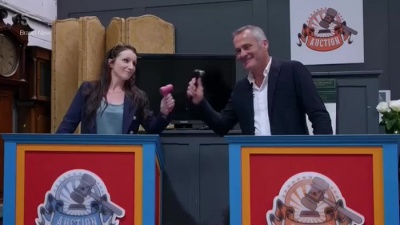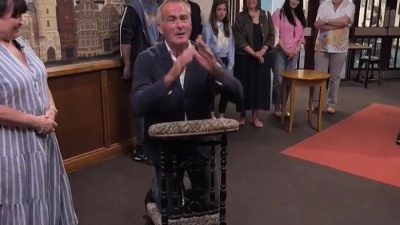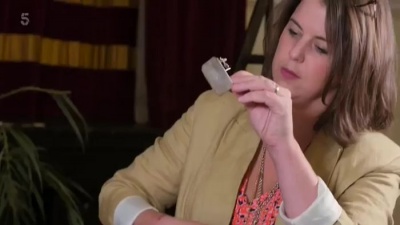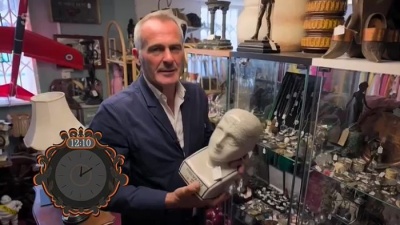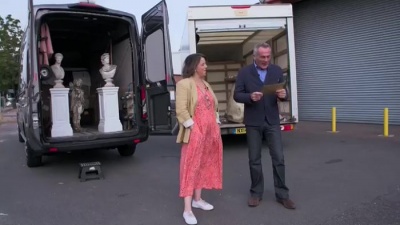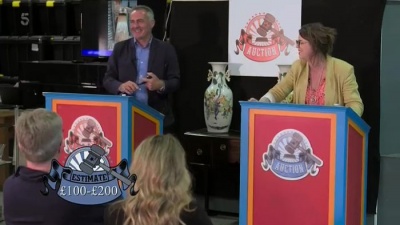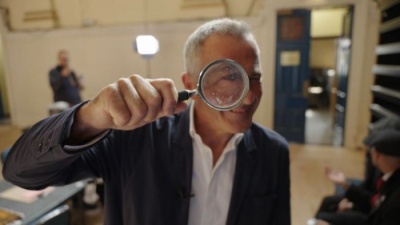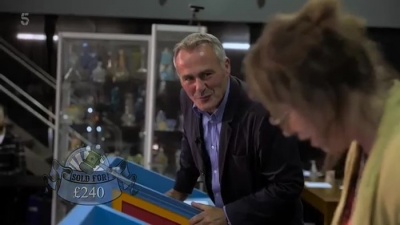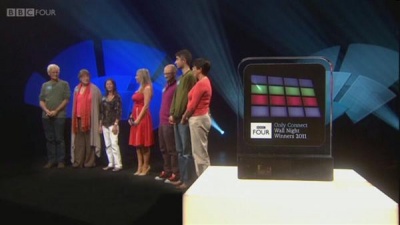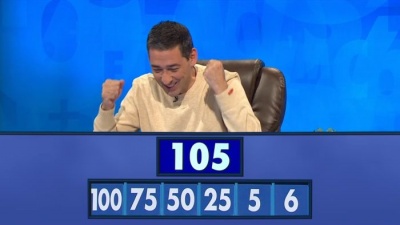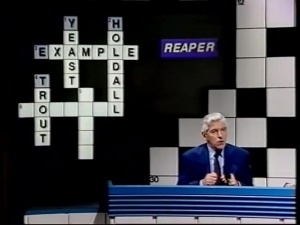Weaver's Week 2023-06-18
Last week | Weaver's Week Index | Next week
"My name's Paul Martin, and I've been in the antiques business for over 25 years."
The Great Auction Showdown with Paul Martin
STV for Channel 5, from 22 May
He says that as though it's something to fear. The show's basic premise is set out in the opening minute: Paul will go head-to-head against a local auctioneer, and attempt to sell some things, buy some more things, and make as much money as he can.
For our sample episodes, we watched the opening week – in Stourbridge, Halfpenny Green, and Bridgnorth, Paul went up against Rachel Holland. Throughout the series, all the fixtures are away matches for Paul, he's always on the other auctioneer's territory, selling in their room.
The bulk of the show is taken up by Accept or Reject, where the players try to pick three items brought in by the public. There's been a call in the local websites to come along to Stourbridge Town Hall, with items and heirlooms and knick-knacks you might want to sell. Paul and Rachel look at the items, talk through some of the more interesting.
Where did you get that chair? What's the story of this teddy bear? A gold disc given away by HRH Sir Cliff Richard – but it's not signed which would have raised the price.
Paul has the choice to not sell items. If they don't think the coronation tea towel will get a sensible price, they won't accept it. The member of the public has the choice not to sell their item, if they think the vintage British Rail sausage roll from 1972 is worth more than £25 they can keep it and use it as the centrepiece of a rockery or something.
But if Paul wants to take on the item, and the price is right, then that's what he'll do. Rachel, also, is able to gently haggle and negotiate and pick up items.
For each episode, the players both get to choose three items from the many brought along by the public. (Of course, this is all a bit artificial; the entire week's filming was done in one day at the Town Hall, and the fifteen items were divvied up into groups of three. We have no problem with this arrangement, as it doesn't alter the gameplay.)
Too many of these public chats would get a bit dull, and it's rare we see more than a couple of rejected items on a show. To break up the programme, part two begins with Flip for Profit, where the contenders are randomly assigned some money (£50, £75, £100). They've half-an-hour to go around an antiques centre and find some item – or items – within their budget. The objective is to sell these items at auction for more than they pay for them.
Any profits from "Flip for Profit" get donated to charity, which is lovely. And profits will be a very rare thing – these dealers are buying at high consumer prices, and selling at low trade prices. Although the shop owner might be prepared to haggle for a few quid, they're still going to take their cut on the deal. You'll only get a profit if you're clever and lucky.
Back to the valuation day, where more items are seen, and some of them are accepted.
The Jackpot Duel is the next fixed point, a little teaser around the middle ad break. Two vans pull up to the back yard, each contains something large and (potentially) valuable. Our contestants are asked a question about the local area. They made the anchor for the Titanic round here – how many horses dragged it from the factory to the train station? The anchor was then taken by train and boat to be fitted in Belfast, sail to Southampton, Cobh, and Davy Jones' Locker.
Whoever comes closer to the answer (in this case, 20 horses) gets first dibs on which of the big lots to sell. Both talk about their lot, and how much they might expect to get for it, and why they think that.
Then it's more items from the valuation day.
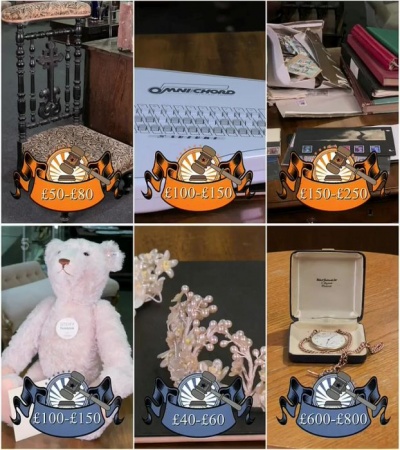 The selections from the public, with expected values. Rachel's items have blue tags, Paul's have orange.
The selections from the public, with expected values. Rachel's items have blue tags, Paul's have orange.
As we near the end of the show, both Paul and Rachel have picked their three items. But there's a twist. Each player can pilfer one of the other player's items, hoping to bag the most valuable lot and sell it under their account.
The final part of the show – anything up to 15 full minutes – is the auction itself. Five items each – three from the public, one from the shop, and one from the jackpot duel. That's ten items in about ten minutes. And that can be a lot of auctioning in one go – but then this show is called The Great Auction Showdown, so we can expect it to be decided in this bidding sale. Not everything will sell – have our contenders pitched their reserves too high?
Scores are kept after each item, so we never lose track of who is scoring and how much they've made. And scores tend to be big and positive – four items will make a profit if sold, the only possible loss comes from the item bought in the shop.
The Great Auction Showdown is made up from bits of other shows. The centrepiece, bring your items to a hall and have them valued, is familiar from Antiques Roadshow. Selling your family knick-knacks for a hundred quid is Flog It and Cash in the Attic all over, while Bargain Hunt and any number of copycats have tried to find a profit in antiques shops.
And there's a definite artifice to this programme. Certainly, the various bits are filmed at different times, and on different days. All the segments in the Town Hall, all the hunting round antiques emporia, and all the jackpot thingies are surely determined on the same day. Then there's some sort of decision to which lot goes with which other lot, and so on. All this decisioning would make for rubbish television, and the producers are right to leave it off screen.
But your average viewer doesn't watch this show and wonder how they put the bits together. The average viewer watches this show for antiques, memories and reminiscences and things half-remembered from childhood – or from an older relatives' sepia-tinged memories. The average viewer watches this show for friendly competition, and doesn't care that it's gently engineered to make Friday decisive if they possibly can.
The average viewer watches The Great Antiques Showdown with Paul Martin for Paul Martin. Knowledgeable, pleasant, charming, able to make the most unlikely topic seem interesting. It's always a pleasure to watch a show with Paul, he's one of the hidden gems of television punditry. Same goes for his sparring partners, who are friends and rivals in that order; the good-natured competition shows on screen.
Sadly, it doesn't show enough on screen. Whether it's Channel 5 doing their usual trick of pulling a show before it's got started, or whether there are production problems and STV have not completed the 80-episode order – we don't know. All we know is that they've shown Stourbridge, Manchester, and Glasgow. Provisional listings said we'd be in Oxfordshire last week, but that got replaced by a cheap obsdoc. That's a shame, they could have built up a bit of steam during June while Tipping Point is in repeats, and then blazed through the autumn. Maybe that's the plan – come back in September with positive quotes from the reviews.
Where else is on the agenda? They filmed in Lincoln and Derby last year, Edinburgh in the spring, also at Sheffield, Cardiff, Lancaster, Newcastle, Ripon, Newbury, Cambridge, Alnwick in Northumberland, the Weald Down Museum, and (of course!) Liverpool.
Certainly we'd like to see some more of this show. It's not the sort of programme this column would normally choose to watch, but we don't regret seeing the eps we did. Paul Martin always adds a certain stardust.
In other news
Pat Sajak has decided to step down from North America's Wheel of Fortune. He's hosted the show since 1981, when Nicky Campbell was still at school, Bradley Walsh was a stand-up comedian, and Paul Hendy was unknown. It's not yet known whether the star of the show, Vanna White, will also leave at the end of next year's series, nor whether young Nick Hewer will take over as host.
We were sorry to hear that Glenda Jackson died this week. Most people have one career in their life; Glenda had a full career as an actress, most famously Elizabeth R in a television series about the ancient queen. And then she went on to spend two decades in the House of Commons, back when it was full of conscientious workers. Glenda's life was so full with good works that she never had time for panel games, nothing more light entertainment than Morecambe & Wise. Glenda Jackson was 87.
Remember the New York Times? The ancient newspaper has launched a new intellectual pastime, "Connections". Arrange four groups of four into groups, with a common theme between each group. We've never seen the like before.
It joins Dig Its, the game where they ask you to make a target number from smaller ones, using the basic arithmetical operations. Last year, they bought a game similar to Lingo.
Connections is just the latest in a number of new ideas from the New York Times. We've truffled through the editor's in-tray and can give exclusive details.
Next month, The Lying Path: get from the start to the finish by travelling through spaces that properly match the theme. In September, Pointless asks how many points the New Jersey Jets will score in their NFLball games.
For Christmas, Whodidit asks which dastardly person committed the crime, where in the building, and with what implement. Coming in 2024, hexagon-joining fun in Lackluster!
And, one day, who knows. Maybe they'll actually manage to make a print version of Crosswits.
Maybe one day RTÉ will learn the lessons of its Eurovision Song Contest failures: the broadcaster has qualified for the Saturday final just once in the past decade. They'll be back for 2024, seeking entries from "contemporary artists and songwriters with the talent and ambition to compete and succeed in this highly competitive environment"; details about the television selection are to be confirmed. We wish them well, and hope to see the Eurovish come back to Millstreet soon.
Can you tell it's the middle of summer? We'd rather be out of doors, and so would the walkers on Am Dro! – a new series begins (S4C, Sun). It's also the Cardiff Singer of the World final (BBC4, BBC2 Wales, Radio 3, Sun).
But it's not just Welsh culture this week. Guessable comes back (Comedy Central, Mon), and Puzzling is scheduled on Channel 5 (Thu). And it's the final of Glow Up (BBC3, Wed), and a celebs versus primary school edition of Portrait Artist of the Year (Artsworld, Wed).
Chris Moyles and Rickie Hayward-Williams on next week's The Hit List (BBC1, Sat), with Rick Edwards and Danny Wallace on Pointless Celebrities. ITV has repeats of The 1% Club, so if you've a good memory, you'll be fine – RTÉ1 also shows some of last year's episodes.
The answer to the Dig Its puzzle? Start with 50 x 6 = 300, then 300 x 100 = 30,000. Now, 30,000 / 5 is 6000, and 6000 / 75 = 80. And you've the 25 left, add that to make 105. Next week's Week plans to look at something even more complex, Get Set Galactic, the new science game show on Cbeebies.
Pictures: STV, Parasol, Yorkshire TV, Tyne Tees TV, EBU/Corinne Cumming/Nathan Reinds/BBC/RAI/NOS/AVROTROS/KAN/UA:PBC/SVT/ÖRF/DR.
To have Weaver's Week emailed to you on publication day, receive our exclusive TV roundup of the game shows in the week ahead, and chat to other ukgameshows.com readers, sign up to our Google Group.


